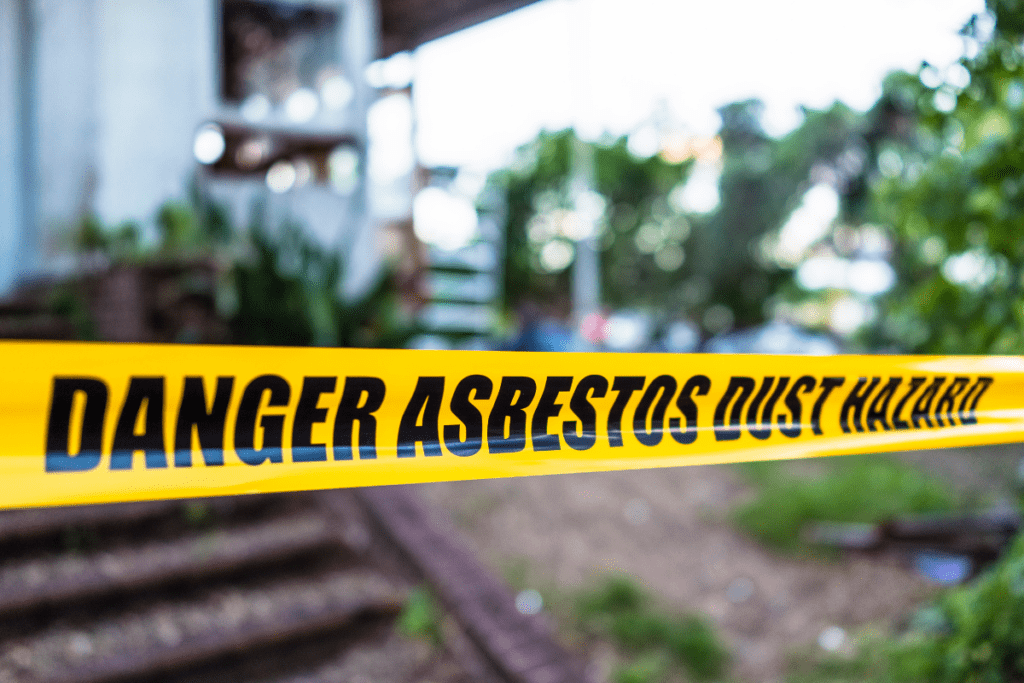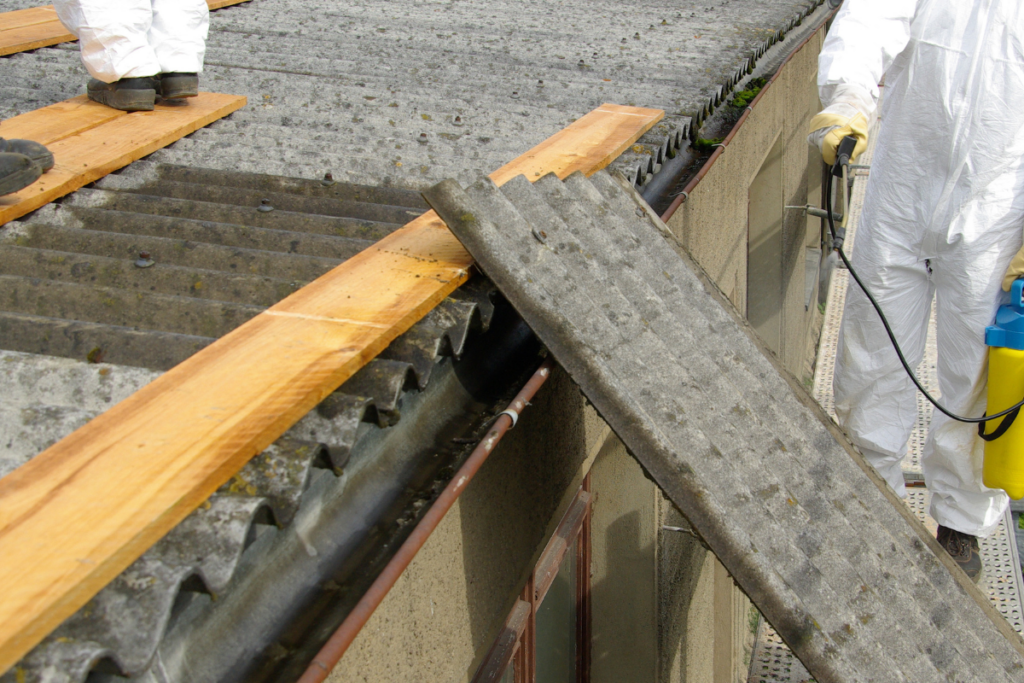Asbestos is a naturally-occurring mineral, once hailed for its resistance to heat, electricity, and corrosion. For this reason it was used extensively in building materials, insulation, and various other products. However, behind its favourable properties is the potential to inflict severe health hazards – some of which are fatal. This article delves into the nature of asbestos, its historical and modern applications, and the underlying reasons that make it a significant concern for public health.
What is asbestos?
Asbestos is a term used to describe six types of heat-resistant fibrous silicate materials. Any product that contains at least one of these six minerals is classified as an ACM (asbestos-containing material).

The six types of asbestos minerals include:
- Actinolite (amphibole): Actinolite asbestos typically has a dark hue. Its primary applications were in products like cement, insulating materials, paints, sealants, and drywall.
- Amosite (amphibole): Often referred to as brown asbestos, amosite is one of the most prevalent types of asbestos. Items possibly containing amosite asbestos are insulating materials, gaskets, and tiles.
- Anthophyllite (amphibole): Anthophyllite asbestos has a colour spectrum ranging from yellowish to brownish. While not a common component in consumer items, it might have been present in certain cement and insulating materials.
- Chrysotile (serpentine): Recognised as the predominant asbestos type and colloquially termed white asbestos, chrysotile constitutes 90% to 95% of US buildings and lots in the UK too. A broad range of products, especially insulating and fire-resistant ones, formerly incorporated chrysotile asbestos.
- Crocidolite (amphibole): Often labeled as blue asbestos, crocidolite has lower heat resistance compared to its counterparts and was less commonly utilised. Some products that might have had crocidolite asbestos are cement, tiles, and insulating materials.
- Tremolite (amphibole): Tremolite asbestos varies in colour, from an opaque white to a deep green. Potential products containing tremolite asbestos could be paints, sealants, and materials for plumbing.
Crocidolite, amosite and chrysotile are much more common than tremolite, anthophyllite and actinolite.
Asbestos-containing materials are categorised according to their friability. This means the ease with which they shed fibres. The higher the friability, the higher the level of risk. Keep reading to find out more about the risks associated. with asbestos.
What was asbestos used for?
ACMS were used widely in the construction industry and the production of consumer items before the health effects and dangers were recognised. Estimates suggest that asbestos was used to create over 3,500 different types of products during the 1960s and 1970s. Asbestos fibres were used in building and construction because they possessed the following properties:
- Heat resistance
- High tensile strength
- Resistance to adverse and extreme weather conditions
- Resistance to chemical exposure and erosion
- Soundproofing
Asbestos was banned in the UK in 1999 (there are a very small number of exceptions). By this time, asbestos fibres had been used to create thousands of products and buildings. As such, it is not uncommon to come across buildings that still contain asbestos. To minimise risks and protect homeowners, tenants, property professionals and people who carry out work on properties, there are regulations in place to prevent exposure to asbestos.
According to the RICS (Royal Institution of Chartered Surveyors), the most common types of asbestos products found in commercial and residential properties include:
- Insulation
- Surface coatings
- Asbestos cement
- AIB (asbestos insulating board)
- Thermoplastic floor tiles
- Decorative features, for example, Artex
- Roofing felt
Why is asbestos so dangerous?
When intact and undisturbed, asbestos does not pose a significant health risk. However, when asbestos-containing materials are disturbed, they can release tiny asbestos fibres into the air. Once inhaled, these fibres can remain in the body for a long time, leading to potential health problems.

The primary danger of asbestos arises when it is disturbed, such as during demolition work, building maintenance, repair, or remodelling, causing asbestos fibres to become airborne. These airborne fibres can be easily inhaled by individuals, and the body cannot degrade them. The inability of our immune system’s chemical defences to break down these fibres makes asbestos particularly dangerous.
However, it’s essential to note that not everyone exposed to asbestos will develop health issues. The risk of developing diseases due to asbestos exposure depends on factors such as the concentration of asbestos in the air, frequency and duration of exposure, and the time elapsed since the exposure began.
What are the health risks of asbestos?
Many people are aware that asbestos is dangerous, but the exact effects of asbestos exposure are less well-known. Data from the HSE (Health and Safety Executive) suggests that more than 5,000 workers per year die as a result of asbestos. Globally, the World Health Organisation estimates that 107,000 lives are lost each year due to asbestos exposure.
Exposure to asbestos is linked to an elevated risk of these conditions:
● Mesothelioma
Mesothelioma is a type of cancer, which affects the linings of the lungs, known as the pleura, and the lower digestive tract, known as the peritoneum. The vast majority of cases of mesothelioma in the UK are associated with asbestos. More than 2,600 cases of mesothelioma are diagnosed every year. Symptoms of mesothelioma include chest pain, fatigue, breathing difficulties, persistent coughing, fever, unexplained weight loss and night sweats. If the peritoneum is affected, additional symptoms include swelling and pain in the stomach, nausea and changes in bowel habits. There is no cure for mesothelioma.
● Asbestos-related lung cancer
Asbestos exposure increases the risk of lung cancer. Asbestos-related lung cancer looks the same as lung cancer caused by smoking, and the symptoms are also similar. Symptoms include a persistent cough, chest pain, shortness of breath and coughing up blood.
● Asbestosis
Asbestosis is a condition, which causes scarring of the lungs as a result of heavy or prolonged exposure to asbestos. This condition is most common among people who worked in construction between the 1960s and the late 1990s. Symptoms tend to develop gradually and include wheezing and hoarseness, a persistent cough, chest and shoulder pain, fatigue and shortness of breath.
● Pleural thickening
Pleural thickening occurs when the lining of the lungs, the pleura, becomes swollen. In most cases, pleural thickening is caused by prolonged or heavy exposure to asbestos. Symptoms include chest pain and breathing difficulties.
The World Health Organisation classes asbestos as a Group 1 carcinogen, which means that the material is known to increase the risk of cancer in humans.
How common is asbestos?
A 2019 report revealed that around six million tons of asbestos remain in the UK. There are approximately 1.5 million buildings that contain asbestos, including hospitals, schools and universities.
Who is at risk?
Asbestos was banned in the UK in 1999. However, it was used widely for decades before the ban was introduced and people became aware of the potential health risks. Most people who develop illnesses and symptoms of conditions that are linked to asbestos worked in building trades between the 1960s and the year 2000. Anyone who works in an environment or setting where asbestos is present may be at risk, but statistics suggest that mesothelioma, asbestos-related lung cancer and asbestosis are most common among people who had or have the following occupations:
- Builders
- Plumbers
- Demolition workers
- Heating and ventilation engineers
- Carpenters
- Electricians
- Joiners
- Shopfitters
People who work in buildings that contain asbestos, for example, teachers and nurses who work in hospitals or schools where asbestos is present, may also be at greater risk than the general public.
Asbestos rules and regulations
All organisations in the UK are legally required to follow rules and regulations related to the use of asbestos and to be proactive in preventing exposure to asbestos to protect employees, clients and the wider general public. Key regulations are outlined by the Health and Safety Executive and govern workplaces and the role of employers. The most crucial points include:
- Prevention or reduction of exposure to asbestos
The best way to reduce the risk of asbestos-related illnesses is to prevent exposure. In some cases, this may not be possible, for example, when trained employees are removing asbestos or they are undertaking work that disrupts or disturbs fibrous materials. If it is not possible to prevent exposure to asbestos, the primary aim is to minimise contact.
- Provision of protective clothing and equipment
Anyone who is required to undertake work that involves exposure to asbestos should be provided with appropriate protective clothing and equipment to reduce exposure. Clothing should also be cleaned and stored in line with HSE guidelines.
- Providing staff training
Asbestos is dangerous, and it requires careful management. Anyone who may be exposed to asbestos as a result of their occupation should have the relevant training and instruction to be able to complete the task and protect themselves to the best of their ability. The level of training required depends on the nature of the job and the risks involved.
- Obtaining the relevant licence
A specialist licence is required to work with high-risk materials, including asbestos. People who are at high risk of developing asbestos-related illnesses should have a licence to fulfil hazardous work. This usually relates to professionals trained in asbestos removal.
- Outlining clear plans
If employees are carrying out work that carries a risk of asbestos exposure, employers are obliged to outline clear plans, which provide details about the site or location, the nature of the work, the hazards detected by risk assessments and the measures taken to lower risks and protect the workforce.
How to manage asbestos
Exposure to asbestos elevates the risk of mesothelioma, asbestos-related lung cancer and asbestosis and it accounts for around 5,500 deaths per year in the UK. In 1999, the use of asbestos was banned and there are now stringent regulations in place to reduce exposure and prevent illnesses associated with asbestos. Duty holders, people who are responsible for the maintenance of non-residential properties in the UK, are required to take steps to manage asbestos. Introduced in 2002, the guidelines outline 7 key steps:
- Determine whether asbestos is present
- Assess the condition and scale of asbestos-containing materials
- Arrange for an asbestos survey
- Draw up a written record or asbestos register
- Create and implement a plan based on the findings of the survey
- Update your records continuously
- Share the information with surveyors, contractors, maintenance workers and anyone else who may be at risk by working on the property
There are two main options for dealing with asbestos: leave and manage or remove harmful materials.
- Leave and manage: It is a common assumption that asbestos poses no risk if it is left alone. If ACMs are not disturbed, the risks may be significantly lower, but if you adopt the leave and manage strategy, it is essential to ensure that materials are inspected regularly. It is also crucial to alert others to the presence of asbestos. If you own a property, for example, and you want to sell or rent a room out, tenants or buyers may be put off because they don’t want to take on the hassle of monitoring ACMs.
- Remove asbestos: The second option, to remove asbestos, can be done as an ongoing process or as a one-off task that is undertaken before building or renovation work, for example. Removing asbestos can save time and effort in the long run. Once asbestos is no longer present, there is no need to carry out checks. There is no legal requirement to remove asbestos but it may be the best option for landlords or homeowners who don’t want to take responsibility for asbestos management in the long term.
Both a Level 2 and Level 3 home survey will point out signs of asbestos in your property. You surveyor will use their professional expertise to detect whether asbestos may be presence and what course of action to take. This is usually in the form of a specialist asbestos survey. It’s important to note that if you’re selling your property, you must disclose if asbestos is present, so it’s a good idea to make yourself aware of it beforehand.




